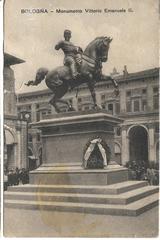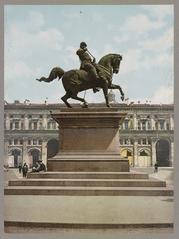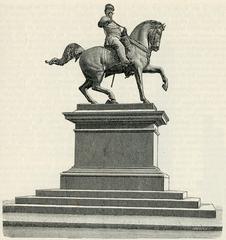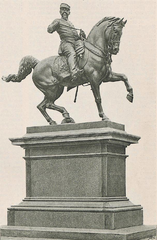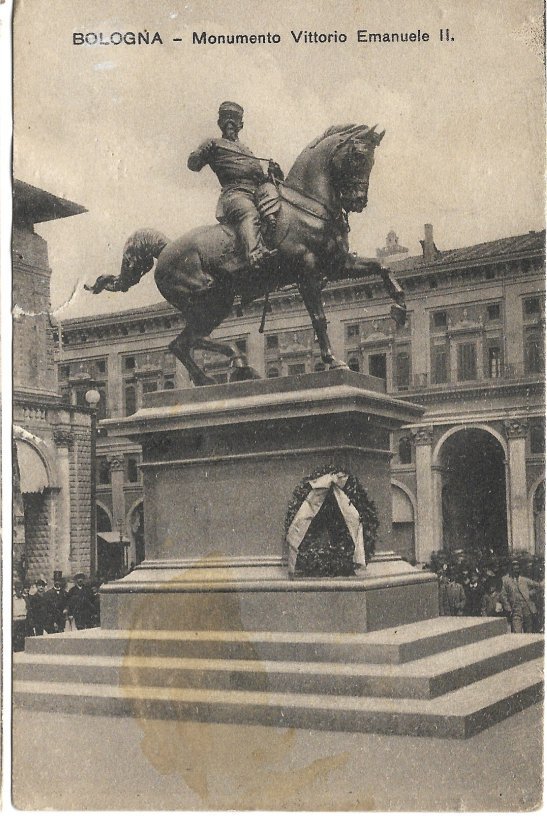
Equestrian Statue of Victor Emmanuel II Bologna: Visiting Hours, Tickets, and Travel Guide
Date: 14/06/2025
Introduction
The Equestrian Statue of Victor Emmanuel II in Bologna stands as a powerful tribute to the first king of unified Italy and a lasting symbol of the Risorgimento—the 19th-century movement that forged the nation’s modern identity. Set in the city’s historic heart, this imposing bronze monument captures Victor Emmanuel II in military attire astride a dynamic steed, embodying leadership, valor, and unity. For visitors, the statue provides not only an artistic and historical focal point but also a window into the political and cultural shifts that shaped contemporary Italy.
This comprehensive guide covers everything you need to know for your visit: from the statue’s historical background and artistic significance to practical details on visiting hours, tickets, accessibility, nearby attractions, travel tips, and responsible tourism. Whether you’re a history enthusiast, an art lover, or a curious traveler, this resource ensures a meaningful and informed experience.
For more on Victor Emmanuel II’s legacy and Italy’s equestrian monuments, see Britannica, VIVE, Northleg, and Travo.
Contents
- Introduction
- Early Life and Ascension to the Throne
- The Path to Italian Unification
- Political Strategy and Alliances
- Military Campaigns and Expansion
- The Monarch’s Legacy: “Father of the Fatherland”
- Symbolism in Art and Monuments
- The Equestrian Statue: Artistic and Cultural Significance
- Historical Background of the Equestrian Statue in Bologna
- Artistic Features and Symbolism
- Location and Urban Context
- Practical Visitor Information
- Visiting Hours
- Tickets and Admission
- Accessibility
- Getting There
- Best Times to Visit
- Nearby Attractions
- Guided Tours and Visitor Experience
- Cultural and Civic Significance
- Notable Events and Anecdotes
- Preservation and Restoration
- Practical Tips for Visitors
- Visitor Services
- Accessibility for Families and Groups
- Responsible Tourism
- Frequently Asked Questions (FAQ)
- Conclusion and Call to Action
- References
Early Life and Ascension to the Throne
Born in Turin in 1820, Victor Emmanuel II was the eldest son of Charles Albert, King of Sardinia-Piedmont. Raised amidst royal responsibilities, he received a military and monarchical education (Britannica). His early adulthood coincided with the revolutionary wave of 1848, which swept across Europe, leading to war between Sardinia-Piedmont and Austria. After his father’s abdication in 1849, Victor Emmanuel II assumed the throne (Wikipedia).
The Path to Italian Unification
Political Strategy and Alliances
Victor Emmanuel II was a pivotal figure in the Risorgimento, collaborating closely with statesman Cavour and revolutionary Garibaldi. He affirmed constitutional monarchy through the Proclamation of Moncalieri, maintaining liberal reforms and attracting support from nationalist and liberal factions (Wikipedia). Strategic alliances, particularly with France under Napoleon III, helped secure victories against Austria and led to the annexation of Lombardy (Britannica).
Military Campaigns and Expansion
Victor Emmanuel II oversaw a series of military campaigns, culminating in the unification of the peninsula. Central Italian states, the Kingdom of the Two Sicilies (after Garibaldi’s campaign), and Veneto (after the Third Italian War of Independence) were incorporated. The final act came in 1870, when Italian troops entered Rome, making it the capital in 1871 (Wikipedia).
The Monarch’s Legacy: “Father of the Fatherland”
Victor Emmanuel II is remembered as the “Father of the Fatherland” (Padre della Patria), a title reflecting his foundational role in creating modern Italy (Wikipedia). Beyond politics, his legacy lives on in monuments and public art.
Symbolism in Art and Monuments
Equestrian statues of Victor Emmanuel II, including Bologna’s, are national symbols. These works often feature allegorical elements that highlight the contributions of Italian cities to unification—Bologna, for example, is traditionally depicted with university regalia and legal texts (VIVE).
The Equestrian Statue: Artistic and Cultural Significance
The Bologna equestrian statue is a focal point of civic pride. Like its counterparts in Rome and other cities, it portrays the king in military regalia atop a powerful horse, symbolizing leadership and the martial virtues that shaped unification (Help Tourists in Rome). Such monuments were typically the results of national competitions, reflecting public participation and artistic excellence (VIVE).
Historical Background of the Equestrian Statue in Bologna
Commissioned after Victor Emmanuel II’s death in 1878, the statue in Bologna was part of a broader national movement to honor the monarch and reinforce ideals of unity, liberty, and progress (Wikipedia). The monument reflects the city’s embrace of national identity and its role in the sweeping urban improvements of the late 19th and early 20th centuries.
Artistic Features and Symbolism
The statue is a masterful bronze work, with Victor Emmanuel II in full military dress, exuding authority and resolve. The equestrian pose draws from ancient Roman traditions exemplified by the statue of Marcus Aurelius (VIVE). Bronze casting, often using melted-down cannons, imbues the monument with historical resonance. The pedestal is typically decorated with allegorical reliefs and inscriptions referencing key moments in the Risorgimento and the values of liberty and unity.
Location and Urban Context
Situated in Piazza del Nettuno, adjacent to Piazza Maggiore and the renowned Fountain of Neptune, the statue anchors one of Bologna’s most vibrant civic spaces. Its prominent location ensures easy access and frequent integration into public events and daily life.
Practical Visitor Information
Visiting Hours
The statue is outdoors and accessible 24/7, all year round.
Tickets and Admission
No tickets or reservations are required; visiting is free.
Accessibility
The piazza is pedestrianized with flat, paved surfaces and ramps. Benches and shade are available nearby.
Getting There
- By foot: Centrally located, within walking distance of major sites.
- By public transport: Multiple city bus routes stop nearby; Bologna Centrale train station is a 15-minute walk away.
Best Times to Visit
- Spring (April–June) and Autumn (September–October): Mild temperatures (11–22°C) and pleasant weather.
- Early morning or late afternoon: Best for photography and avoiding crowds.
- The statue is illuminated at night for dramatic views.
Nearby Attractions
- Piazza Maggiore: The city’s main square, home to the Basilica di San Petronio and Palazzo d’Accursio.
- Fountain of Neptune: Renaissance sculpture adjacent to the statue.
- Medieval Towers (Due Torri): Iconic landmarks offering panoramic views.
- Archiginnasio of Bologna: Historic university building.
- Museo Civico Archeologico: Archaeological museum nearby.
Guided Tours and Visitor Experience
Many walking tours include the statue as a highlight, offering insights into its history and broader context within Bologna’s urban landscape. Photography enthusiasts will appreciate the monument’s dynamic lines and artistic detail.
Cultural and Civic Significance
The statue is a living symbol of Bologna’s connection to Italian nationhood. It serves as a backdrop for civic ceremonies, national holidays, and public gatherings, reinforcing its role as a focal point for collective memory and education.
Notable Events and Anecdotes
The statue’s unveiling was a major civic event. Over time, it has witnessed political rallies and cultural festivals. A popular anecdote claims the horse’s belly was once large enough to seat a small gathering for a celebratory meal prior to installation (VIVE).
Preservation and Restoration
Local authorities and heritage organizations regularly maintain the monument, undertaking cleaning and restoration to preserve its condition and improve the surrounding landscape.
Practical Tips for Visitors
- Combine your visit with other historical sites for a full Bologna experience.
- Join a guided walking tour for expert insights.
- Check local event calendars for public ceremonies.
- Respect the monument: Do not climb or deface, and follow posted guidelines.
- Wear comfortable footwear for exploring the area.
Visitor Services
- Tourist Information: Points in Piazza Maggiore provide maps and assistance.
- Wi-Fi: Free public Wi-Fi is available in the city center.
- Souvenirs: Shops nearby offer Bologna and Italy-themed memorabilia.
Accessibility for Families and Groups
The open piazza is ideal for families and groups. Wheelchairs and strollers can navigate the area with ease. Group tours should be booked in advance during busy seasons.
Responsible Tourism
Respect the monument and its surroundings. Dispose of litter properly, refrain from climbing on the statue, and maintain decorum during events and ceremonies.
Frequently Asked Questions (FAQ)
Q: What are the visiting hours for the Equestrian Statue of Victor Emmanuel II in Bologna?
A: The statue is outdoors and accessible 24/7, year-round.
Q: Is there an admission fee or tickets required?
A: No, visiting the statue is free.
Q: Are guided tours available?
A: Yes, many local operators offer guided tours that include the statue.
Q: Is the site wheelchair accessible?
A: Yes, the area is fully accessible with ramps and flat walkways.
Q: What is the best time for photography?
A: Early morning or late afternoon for optimal lighting; the statue is also beautifully illuminated at night.
Conclusion and Call to Action
The Equestrian Statue of Victor Emmanuel II in Bologna is far more than a monument—it is a vibrant emblem of Italy’s unification and a testament to civic pride. Its central location, free public access, and integration into the life of the city make it a must-see for travelers and locals alike. For a deeper experience, combine your visit with nearby historical sites, consider a guided tour, and check for special events at the monument.
For up-to-date travel information, guided tour bookings, and additional tips, download the Audiala app and explore our other guides on Bologna’s historical attractions. Stay connected via our social channels for the latest news and cultural events.
For further reading on equestrian statues and Victor Emmanuel II, visit the Wikipedia list of equestrian statues in Italy and the VIVE cultural site.
Images and interactive maps are recommended to accompany this guide, with descriptive alt text such as “Equestrian Statue of Victor Emmanuel II Bologna at sunset” and “Visiting Statue of Victor Emmanuel II”.
References and Further Reading
- Britannica: Victor Emmanuel II Biography
- Wikipedia: Victor Emmanuel II
- Wikipedia: Victor Emmanuel II Monument
- Wikipedia: List of Equestrian Statues in Italy
- VIVE: Base of the Statue of Victor Emmanuel II on Horseback
- Northleg: Equestrian Statue of Victor Emmanuel II in Rome
- Travo: Equestrian Statue of Victor Emmanuel II, Rome
